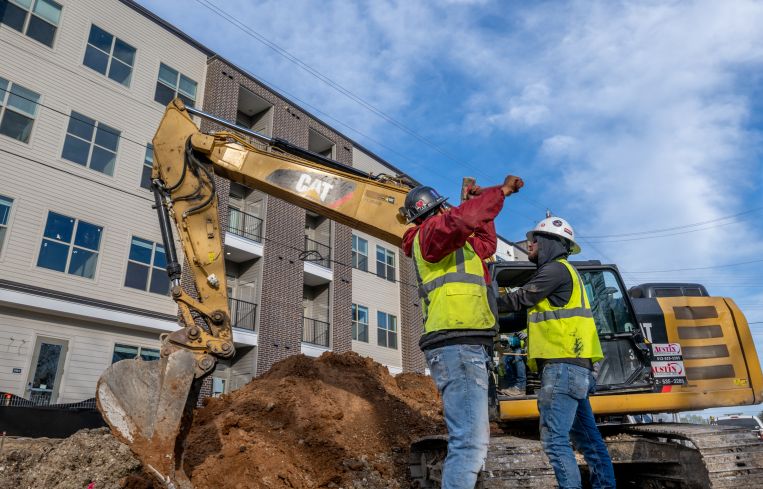Multifamily Developers Need to Lean Into Tech as Tariffs Take Hold
By William Sankey March 27, 2025 9:00 am
reprints
It is widely known that the real estate industry has faced significant challenges following the COVID-19 pandemic, including unprecedented office vacancies, high interest rates and ongoing housing affordability concerns. Now, with the Trump administration’s recent tariffs, the industry is bracing for new challenges as construction costs surge.
These tariffs are expected to indirectly yet significantly affect multifamily housing in particular by driving up the cost of construction materials. As the price of materials such as steel and lumber rises (as we are already seeing with domestic providers) and labor costs increase, we’ll likely see a decline in new developments, worsening the housing supply shortage and driving up rent.
In the short term, developers will face higher costs as companies rush to stock up on supplies as tariffs take effect. Projects and deals may face delays due to heightened uncertainty or collapse entirely due to the already high cost of capital and labor combined with rising material costs.
Despite short-term hurdles, there may be long-term benefits. If tariffs drive more reshoring of manufacturing, industrial real estate could see a boost, and the supply chain may become more predictable and resilient with more domestic production of construction materials.
To effectively plan and future-proof their portfolios, developers must streamline administrative tasks like securing labor, managing paperwork, and coordinating projects. By strategically leveraging technology, developers can automate processes, streamline decision-making, and improve cost predictability, helping them remain competitive while managing risks.
During the first Trump administration, tariffs were phased in over two years, and focused on China, allowing developers time to prepare.
This round, however, the shift has been more immediate and extends to Mexico and Canada — critical suppliers of essential housing materials, including steel, HVAC equipment, concrete, roofing supplies and lumber. While larger developers may have anticipated these tariffs, small to midsize developers lack the same advantage or bandwidth.
With multifamily starts already declining, the tariffs further intensify the urgency of addressing the future housing supply. I expect even fewer projects to happen due to the increased construction costs, worsening the housing supply issue in the coming years and driving up rents.
One area where tariffs may shift industry dynamics is office-to-residential conversions. Compared to the financial burden of ground-up construction, utilizing existing structures is more favorable. As interest in conversions grows, we may see greater emphasis on repurposing underutilized, obsolete office buildings in urban centers.
Regardless, in this environment, the most critical component is the planning phase. Developers must identify where to include off-ramps and alternatives when costs become untenable on certain items. This will allow developers to identify roadblocks and risks early, including where alternatives may not be viable.

It’s hard to change the cost of materials, but there are other opportunities in the value channel of project creation where we can reduce and contain costs. To help address and deliver the much-needed housing supply, developers must transform how they operate, much like advanced manufacturing has done over the past two decades. In that sector, there has been a surge in digital transformation, driven by AI, automation and data analytics, leading to increased efficiency, productivity and supply chain resilience.
Developers spend approximately 30 to 40 percent of their time on administrative tasks. This is a cost in effort and staffing labor, but also a cost in strategic focus. When focused on paperwork, developers have less time to plan and explore ways to mitigate risks. With traditional planning methods, projects are overschedule and overbudget 75 percent of the time.
End-to-end development management software can help streamline operations by automating tasks and providing data-driven insights. These platforms enable faster, smarter decisions. Budget revisions that once took hours can now be completed in minutes, allowing for more proactive planning. Such tools can reduce cost overruns by up to 66 percent, improving project predictability and profitability.
Furthermore, capital partners increasingly expect developers to leverage modern technology. In today’s competitive capital environment, reliance on traditional and outdated methods adds unnecessary risk to successful execution. Lenders and investors prioritize developers who utilize technology for seamless control over project financials and costs.
Companies that will struggle in this new era are those that continue to rely on spreadsheets, make gut-driven rather than data-driven decisions, and fail to recognize patterns during the project planning phase due to a lack of institutional knowledge.
Real estate development is a game of risks, and supply chain disruptions are more pronounced. It’s time for the status quo of development to come to an end.
William Sankey is the CEO and co-founder of Northspyre, the only end-to-end real estate development management platform.


